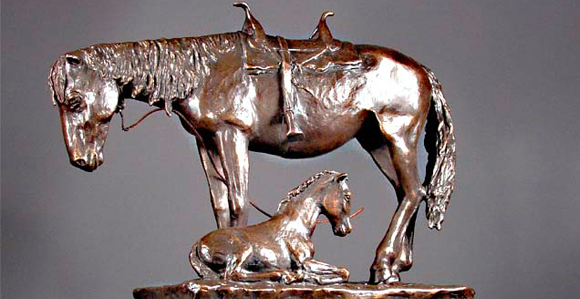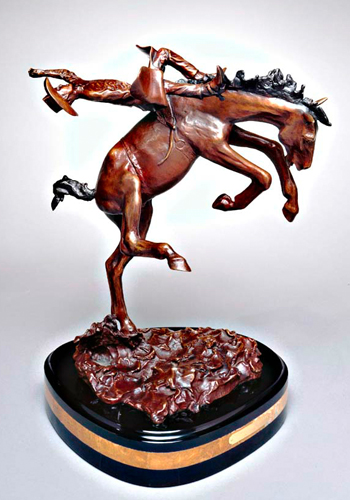LDS Father of Modern Rodeo Inducted into Hall of Fame
Contributed By By Michael Ann McKinlay, Church News staff writer

With a degree in art, Earl Bascom created bronze sculptures depicting western culture.
Article Highlights
- Four of Earl’s family members have also been inducted into rodeo or sports halls of fame over the years.
- Earl Bascom not only broke rodeo records but also “is considered one of the great innovators in rodeo history.”
- Brother Bascom studied art in college and today his paintings and sculptures are featured in museums around the western United States.
“Many looked up to him. He was a spiritual man, always honest in his dealings.”
—John Bascom, son of Earl Wesley Bascom
Related Links
OKLAHOMA CITY
“If you want to be a champion bull rider, you have to ride the toughest bull,” was Earl Wesley Bascom’s philosophy in life. Though it has been 18 years since his death, his legacy still lives on.
In September, Brother Bascom was inducted into the Rodeo Hall of Fame at the National Cowboy and Western Heritage Museum located in Oklahoma City, Oklahoma.
His youngest son, John A. Bascom of the Ranchero Ward, Apple Valley California Stake, attended the ceremony on his behalf.
“It was a great reception,” Brother Bascom said. “Over 350 people were in attendance.”
Earlier this year, Earl Bascom was inducted into the Alberta Sports Hall of Fame and the Utah Rodeo Hall of Fame. He is the latest and ninth overall LDS cowboy to be recognized on a national level in Oklahoma.
Earl Bascom comes from a very rodeo-centric family. His brothers Raymond, Melvin, and Weldon Bascom; his father, John W. Bascom; and his sister-in-law Rose Bascom have all been inducted into rodeo or sports halls of fame over the years.
Earl Bascom participated in rodeo from 1916 to 1940 throughout the western United States and Canada, setting the world record time, becoming a reserve champion at the Calgary Stampede, and placing third in the world standings, all in 1933.
With the Word of Wisdom and Church values as his foundation, Brother Bascom had a long and successful rodeo career.
“One thing that helped me in my rodeo career was some advice that an old-time rider, Walt Whitney, gave me,” Brother Bascom recounted in a biography posted online. “He said that if you want to succeed in rodeo don’t ever smoke or drink.”
In addition to breaking rodeo records, Earl Bascom was innovative in making his own rodeo equipment, including saddles, chaps, cuffs, quirts (braided leather lashes), and spurs. John Bascom said his father was “a pioneer of the sport of rodeo.”
A statement from the Alberta Sports Hall of Fame noted that Earl Bascom “was always looking for ways to improve the equipment and is considered one of the greatest innovators in rodeo history and one of Canada’s greatest inventors. Many of his innovations are now standard rodeo equipment.”
Brother Bascom also helped spread rodeo to the South, with the help of his brother Weldon. In between serving missions for the Church in the southern States, the Bascom brothers, along with other LDS cowboys from Utah and Arizona, put on the first outdoor rodeo under electric lights in Columbia, Mississippi.
Rodeo helped Brother Bascom not only receive fame but also fund a college education where he developed his artistic skills. He was “rodeo’s first collegiate cowboy.”
Though rodeo was a major passion for Earl Bascom, he always dreamed of being an artist, John explained. It wasn’t until he went to BYU in his late 20s that he was able to fulfill that dream.
Earl Bascom graduated from BYU in 1940 and was planning on attending art school in California. However, during World War II, he built warships on the docks of Long Beach, California.
After the war and various ranching jobs, he taught art at Barstow High and John F. Kennedy High School in Southern California. He also served as president of the local art association, Artists of the High Desert.
However, it wasn’t until his retirement years that he could freely create his own bronze sculptures, mostly depicting the western culture he lived and breathed. Brother Bascom set up his first bronze-casting foundry with John.

Bascom’s paintings and bronze sculptures can be found in museums around the western United States. Photo courtesy BascomBronze.com. © Copyrighted by Bascom Productions.
Today, his paintings and sculptures are featured in museums around the western United States, including the Denver Art Museum, Dallas Museum of Fine Art, and California Route 66 Museum.
“He came from a humble background,” Donald Bigler, from the Desert Knolls Ward, Apple Valley California Stake, said. “Subsequent to his early childhood shortcomings, he was able to go to school and taught art classes later in his life. He accomplished so much.”
Earl Bascom served in the Church through various callings, including as bishop and as patriarch of the Barstow and Victorville California Stakes.
Brother Bigler served on the stake presidency and as a stake president while Brother Bascom was the stake patriarch in Southern California.
“He was one of those people that I would consider a solid Saint in the kingdom,” he said.
“He was faithful and true to the gospel,” John said. “Many looked up to him. He was a spiritual man, always honest in his dealings.”
Earl Wesley Bascom was born on June 19, 1906, in Vernal, Utah, and married Nadine Diffey in the Salt Lake Temple in December of 1939. They were the parents of five children. Sister Bascom recently passed away at the age of 97.
